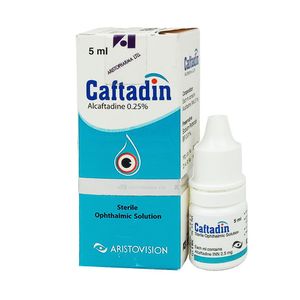Caftadin Uses, Dosage, Side Effects and more
Caftadin is an H1, H2 & H4 histamine receptor antagonist and inhibitor of the release of histamine from mast cells. The activation of H1 receptor causes itching & H4 receptor causes itching & inflammation. Histamine binding with H1 & H2 receptor causes redness and swelling. Caftadin also inhibit the release of histamine from mast cell through limit the entry of Ca++ across the membrane as a result prevent degranulation. Caftadin also stabilize tight junction protein (zonula occludin) of conjuctival epithelium that normally becomes disorganized following allergen exposure so that decreased chemotaxis and inhibition of eosinophil activation has also been demonstrated.
Following bilateral topical ocular administration of alcaftadine ophthalmic solution, 0.25%, the mean plasma Cmax of alcaftadine was approximately 60 pg/mL and the median Tmax occurred at 15 minutes. Plasma concentrations of alcaftadine were below the lower limit of quantification (10 pg/mL) by 3 hours after dosing. The mean Cmax of the active carboxylic acid metabolite was approximately 3 ng/mL and occurred at 1 hour after dosing. Plasma concentrations of the carboxylic acid metabolite were below the lower limit of quantification (100 pg/mL) by 12 hours after dosing.

| Attribute | Details |
|---|---|
| Trade Name | Caftadin |
| Generic | Alcaftadine |
| Alcaftadine Other Names | Alcaftadina, Alcaftadine, Alcaftadinum |
| Weight | 0.25% |
| Type | Eye Drops |
| Formula | C19H21N3O |
| Weight | Average: 307.3895 Monoisotopic: 307.168462309 |
| Protein binding | The protein binding of alcaftadine and the active metabolite are 39.2% and 62.7% respectively. |
| Groups | Approved |
| Therapeutic Class | Ophthalmic Anti-allergic preparations |
| Manufacturer | Aristopharma Ltd |
| Available Country | Bangladesh |
| Last Updated: | January 7, 2025 at 1:49 am |
Uses
Caftadin is used for the prevention of itching associated with allergic conjunctivitis.
Caftadin is also used to associated treatment for these conditions: Seasonal Allergic Conjunctivitis
How Caftadin works
Caftadin is a H1 histamine receptor antagonist and inhibitor of the release of histamine from mast cells. Decreased chemotaxis and inhibition of eosinophil activation has also been demonstrated.
Dosage
Instill one drop in each eye once daily.
How Long Does It Take to Work?
How Long Does It Take to Work? see here Caftadin
Side Effects
Reported side effects are irritation, burning, eye redness, itching etc. Other side effects are headache, ocular pruritus and nasopharyngitis.
Precaution
The drug should not be instilled while wearing contact lenses. If hypersensitivity reaction occurs after instillation patients should be advised to discontinue the use of Caftadin and consult with physicians.
Food Interaction
No interactions found.Half Life
The elimination half-life of the carboxylic acid metabolite is approximately 2 hours following topical ocular administration.
Elimination Route
Based on data following oral administration of alcaftadine, the carboxylic acid metabolite is primarily eliminated unchanged in the urine.
Pregnancy & Breastfeeding use
Caftadin is pregnancy Category B. Caftadin has not been shown to cause birth defects or other problems during pregnancy and breastfeeding. It is not known whether Caftadin is secreted in human milk or not. Caution should be exercised when Caftadin is administered to a nursing mother.
Contraindication
It is contraindicated in persons with a known hypersensitivity to any component of this product.
Special Warning
Pediatric Use: Safety and effectiveness in pediatric patients below the age of 2 years have not been established.
Geriatric Use: No overall differences in safety or effectiveness were observed between elderly and younger subjects.
Acute Overdose
Ocular Adverse Reactions: The most frequent ocular adverse reactions, occurring in <4% of alcaftadine eye drops treated eyes were eye irritation, burning and/or stinging upon instillation, eye redness and eye pruritus.
Non-ocular Adverse Reactions: The most frequent non-ocular adverse reactions, occurring in <3% of subjects with alcaftadine eye drops treated eyes, were nasopharyngitis, headache and influenza. Some of these events were similar to the underlying disease being studied.
Interaction with other Medicine
No information is available.
Storage Condition
- Store in a cool, dry place and protected from light.
- Keep out of the reach of children.
- Discard the container 4 weeks after opening.
Innovators Monograph
Caftadin contains Alcaftadine see full prescribing information from innovator Monograph, MSDS, FDA label



